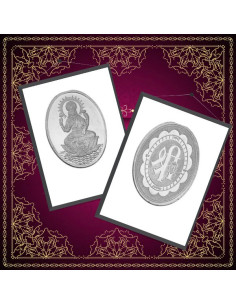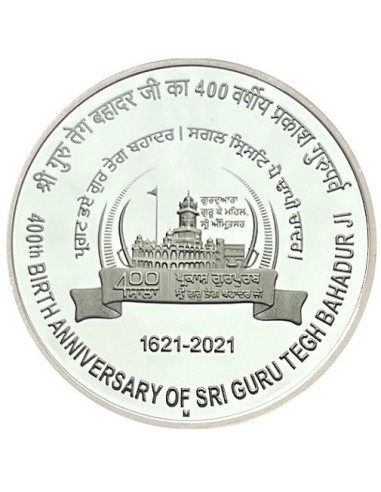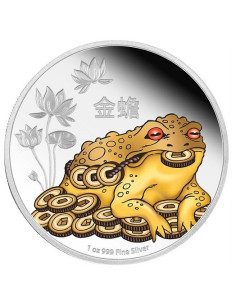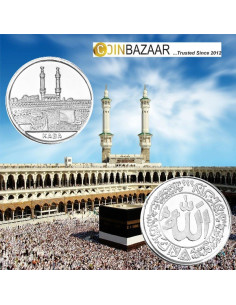
- Online only
400 Rupees India Govt. Mint 400th Birth Anniversary of Sri Guru Tegh Bahadur ji Commemorative Coin (Rs.400 Coin) | Coinbazaar
Buy Limited Edition 400 Rupees India Govt. Mint 400th Birth Anniversary of Sri Guru Tegh Bahadur ji Commemorative Coin (Rs.400 Coin)
400 Rupees India Govt. Mint 400th Birth Anniversary of Sri Guru Tegh Bahadur ji Commemorative Coin (Rs.400 Coin)
Commemorative Coins :
manufacturing circulation coins. These coins are issued to commemorate events of historical
and social importance and to celebrate various accomplishments of public and private
organizations. India Government Mint, Mumbai has been releasing commemorative coins since
1964. The commemorative coins issued by the Mint are of very high quality and have a great
demand among coin collectors and numismatists.
Commemorative coins are of two types
Proof Coins
Uncirculated Coins
Proof Coins:
Proof coins are the high quality commemorative coins which have a frozen effect on the surface
design of the coin with a mirror finish. These coins are marked with the symbol 'M' to indicate
that they are manufactured at Mumbai Mint. These coins are sold at a premium price as they
are manufactured with high quality standards and have high numismatic value.
Uncirculated Coins:
Uncirculated coins are the high quality commemorative coins which have mirror finish on the
surface but without any frozen effect on the design. These coins are marked with a diamond
symbol to indicate they are stamped at Mumbai Mint. The uncirculated coins are also sold at
premium but they are priced a little lower than the proof coins.
History
In 1964 production of commemorative coins was started. The first commemorative coin was in the memory of Pandit Jawaharlal Nehru.
SRI GURU TEGH BAHADUR JI Sri Guru Tegh Bahadur Ji (1621-1675) was the ninth Sikh Guru. Guruji was the grandson of first Sikh martyr Guru Arjan Devji and son of Guru Hargobind Ji (Sixth Guru and founder of Sri Akal Takht and grandfather of Guru Gobind Singh Ji). Considered as a principled and fearless warrior, Guru ji was a learned spiritual scholar and a poet whose 116 hymns are included in Sri Guru Granth Sahib, the main text of Sikhism.
Guru Harikrishan ji bestowed Guru Gaddi upon Guru Tegh Bahadur ji. Guru Tegh Bahadur Ji was brought up in Sikh culture and trained in archery and horsemanship. Guru ji was also taught the classic spiritual texts like Vedas, Upanishads, Puranas. and proficiency of Indian classic musicology. Guru ji preferred prolonged spells of seclusion and contemplation. Guru Ji's valour shown in a battle against Mughals, gave him the name as Tegh Bahadur (Might of the Sword).
In 1664 Guru ji was declared as the ninth Guru of Sikhs. He travelled extensively across India and founded the city of Anandpur Sahib in the foothills of Himalayas. Guru Ji made extensive travels in Shivalik Hills, South Punjab, Haryana, Bihar, Bengal, Uttar Pradesh and Assam. Guru Ji was executed in November 1675 in Delhi by the Order of Mughal Emperor Aurangzeb, for taking up the cause of religious freedom of Kashmiri Pandits. He was kept in jail for four months in Sarhind and then transferred to Delhi in November 1675. Guru Ji was asked to perform miracle to prove his nearness to the God. Guru Ji questioned the idea, stating that "occult powers were not a proof of one's proximity to the God" After his refusal to demonstrate a miracle, Guru ji was asked to convert to Islam but Guruji refused. Three of his associates who were arrested along with him were put to death in front of him. Then after his refusal to convert to Islam, Guru Ji was beheaded in Chandni Chowk, Delhi. Gurdwara Sis Ganj Sahib and Gurdwara Rakab Ganj Sahib in Delhi are two historical sites significantly associated with the sacred memory and supreme sacrifice of Guru Ji.
The sacred compositions of Guru Tegh Bahadur Ji are a great reflection on the idea of devotion and purpose of human life. Guru Tegh Bahadur Ji was the only Sikh Guru who composed his Bani in Raga Jayjawanti. Guru Tegh Bahadur Ji is remembered as a Guru who stood for religious freedom and solidarity of the country. Guru Tegh Bahadur Ji thus earned the affectionate title of “Hind – di Chadar” or “the Shield of India”. Guru Ji would always be remembered for his bravery and concern for social harmony.
|
DENOMINATION OF THE COIN |
SHAPE, DIAMETER & No. OF SERRATION |
WEIGHT |
METAL COMPOSITION |
|
Four Hundred Rupees |
|
35.00 gms |
Quaternary Alloy Silver- 50 %, Copper - 40 %, Nickel- 05 % and Zinc- 05 % |
- Country
- India





















